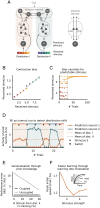Prediction-error neurons in circuits with multiple neuron types: Formation, refinement, and functional implications
- PMID: 35320037
- PMCID: PMC9060484
- DOI: 10.1073/pnas.2115699119
Prediction-error neurons in circuits with multiple neuron types: Formation, refinement, and functional implications
Abstract
SignificanceAn influential idea in neuroscience is that neural circuits do not only passively process sensory information but rather actively compare them with predictions thereof. A core element of this comparison is prediction-error neurons, the activity of which only changes upon mismatches between actual and predicted sensory stimuli. While it has been shown that these prediction-error neurons come in different variants, it is largely unresolved how they are simultaneously formed and shaped by highly interconnected neural networks. By using a computational model, we study the circuit-level mechanisms that give rise to different variants of prediction-error neurons. Our results shed light on the formation, refinement, and robustness of prediction-error circuits, an important step toward a better understanding of predictive processing.
Keywords: homeostatic plasticity; inhibitory interneurons; prediction-error neurons; predictive processing; sensory coding.
Conflict of interest statement
The authors declare no competing interest.
Figures





Similar articles
-
Learning prediction error neurons in a canonical interneuron circuit.Elife. 2020 Aug 21;9:e57541. doi: 10.7554/eLife.57541. Elife. 2020. PMID: 32820723 Free PMC article.
-
Reliable Sensory Processing in Mouse Visual Cortex through Cooperative Interactions between Somatostatin and Parvalbumin Interneurons.J Neurosci. 2021 Oct 20;41(42):8761-8778. doi: 10.1523/JNEUROSCI.3176-20.2021. Epub 2021 Sep 7. J Neurosci. 2021. PMID: 34493543 Free PMC article.
-
Evaluating the extent to which homeostatic plasticity learns to compute prediction errors in unstructured neuronal networks.J Comput Neurosci. 2022 Aug;50(3):357-373. doi: 10.1007/s10827-022-00820-0. Epub 2022 Jun 3. J Comput Neurosci. 2022. PMID: 35657570
-
The Role of Inhibitory Interneurons in Circuit Assembly and Refinement Across Sensory Cortices.Front Neural Circuits. 2022 Apr 7;16:866999. doi: 10.3389/fncir.2022.866999. eCollection 2022. Front Neural Circuits. 2022. PMID: 35463203 Free PMC article. Review.
-
The ins and outs of inhibitory synaptic plasticity: Neuron types, molecular mechanisms and functional roles.Eur J Neurosci. 2021 Oct;54(8):6882-6901. doi: 10.1111/ejn.14907. Epub 2020 Aug 9. Eur J Neurosci. 2021. PMID: 32663353 Free PMC article. Review.
Cited by
-
Prediction-error signals in anterior cingulate cortex drive task-switching.Nat Commun. 2024 Aug 17;15(1):7088. doi: 10.1038/s41467-024-51368-9. Nat Commun. 2024. PMID: 39154045 Free PMC article.
-
Neural learning rules for generating flexible predictions and computing the successor representation.Elife. 2023 Mar 16;12:e80680. doi: 10.7554/eLife.80680. Elife. 2023. PMID: 36928104 Free PMC article.
-
Uncertainty-modulated prediction errors in cortical microcircuits.Elife. 2025 Jun 5;13:RP95127. doi: 10.7554/eLife.95127. Elife. 2025. PMID: 40471208 Free PMC article.
-
Desegregation of neuronal predictive processing.bioRxiv [Preprint]. 2024 Aug 7:2024.08.05.606684. doi: 10.1101/2024.08.05.606684. bioRxiv. 2024. PMID: 39149380 Free PMC article. Preprint.
-
CONSTRUCTING BIOLOGICALLY CONSTRAINED RNNS VIA DALE'S BACKPROP AND TOPOLOGICALLY-INFORMED PRUNING.bioRxiv [Preprint]. 2025 Jan 13:2025.01.09.632231. doi: 10.1101/2025.01.09.632231. bioRxiv. 2025. PMID: 39868098 Free PMC article. Preprint.
References
-
- Rao R. P., Ballard D. H., Predictive coding in the visual cortex: A functional interpretation of some extra-classical receptive-field effects. Nat. Neurosci. 2, 79–87 (1999). - PubMed
-
- Schultz W., Dickinson A., Neuronal coding of prediction errors. Annu. Rev. Neurosci. 23, 473–500 (2000). - PubMed
-
- Keller G. B., Bonhoeffer T., Hübener M., Sensorimotor mismatch signals in primary visual cortex of the behaving mouse. Neuron 74, 809–815 (2012). - PubMed
MeSH terms
Grants and funding
LinkOut - more resources
Full Text Sources

